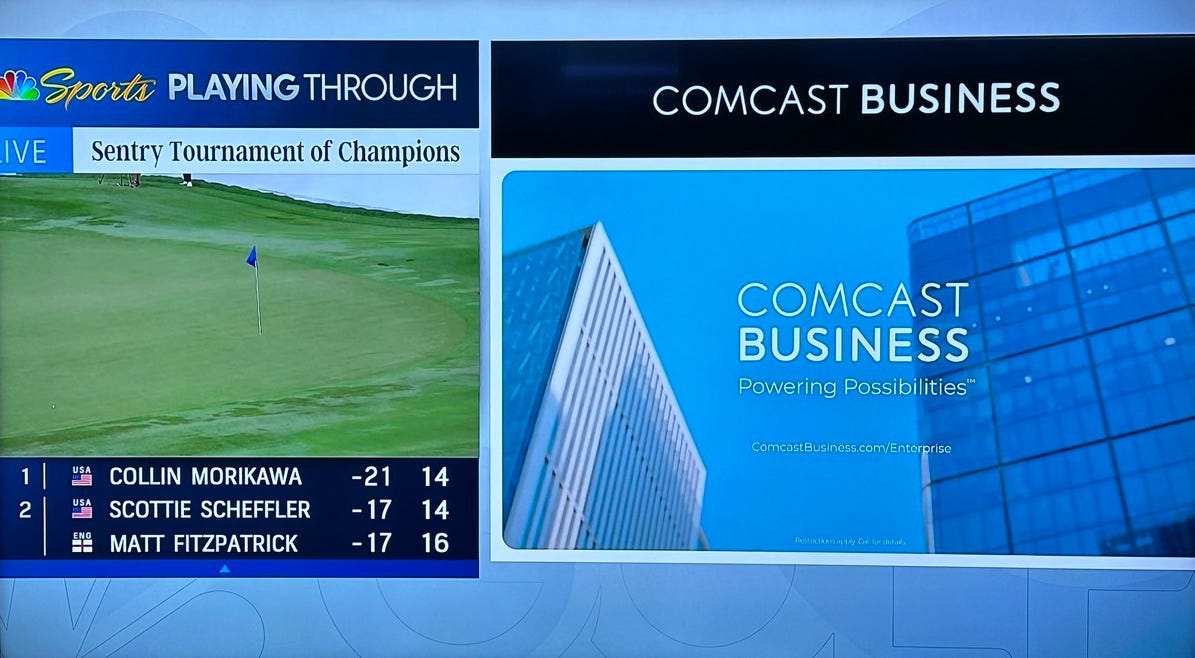Coming In 2023: An Urgency To Improve Televised Golf
A Sports Business Journal story explains how the PGA Tour is working with networks to improve all golf telecasts. It showed at Kapalua. Plus, a few notes following Jon Rahm's shocking comeback win.
Apparently it took an existential crisis to inspire sensible golf television changes. Maybe.
Based on what Josh Carpenter’s Sports Business Journal story about PGA Tour adjustments in the works with their partners at CBS and NBC, some combination of declining ratings, common sense, social media feedback and sponsor cooperation has prompted adjustments to stuff such as the way commercials are incorporated or the importance of scene-setting to give Tour events a bigger feeling. Player sound sounds like it’s still a kinda-sorta thing and it’s unclear if the improvements will be incorporated at NBC’s non-Masters major championships. But it appears the TV discussion was prompted by—what else—LIV’s commercial-free emergence.
Coupled with the overall tensions created by network budget-slashing, forced retirements, “ironclad contract” renegotiations (Discovery/GolfTV) and no clear answer about the financial viability of streaming, 2023 will be the year broadcasting gets plenty of attention.
Here’s a look at what Carpenter reported in the story titled “PGA Tour making efforts to streamline broadcast product in 2023,” which is centered around how “the Tour, broadcast and corporate partners are working together to show more golf on their platforms.”
Some highlights from Carpenter’s story along with my reactions, plus notes on changes already witnessed in the Golf Channel shows from Kapalua:
The move: Commercial free final hours. This option, according to NBC producer Tommy Roy, will be available to all sponsors and events. This is an obvious and overdue move after the successful incorporation of Rolex’s sponsorship at the U.S. Open dating to the Fox years.
Reaction: It’s unclear why this is only now something to do on a Tour broadcast, but we’ll take what should become standard on all significant events. Callaway took the opportunity at the Sentry TOC and it was tremendous. The stark difference in staying with the closing stretch action as Collin Morikawa folded gave the announcers time to put the shocking conclusion into better perspective without having to worry going to a break or cross-promoting…oh wait, they had to do a little of that. But the important thing to remember: execution of Callaway’s final hour sponsorship was not overbearing nor disrespectful to Sentry. And what a huge difference this made for viewers.
The move: Taking the contractually obligated 18th tower CEO interviews to Saturdays.
Reaction: What does it say about the egos of CEO’s that this has to be gingerly presented publicly through an industry publication when it’s such lay-up? I can imagine Commissioner calls that get sent to voicemail knowing the likely reason he’s calling. “Hey Bob, it’s Jay here, congrats on the third quarter earnings! Those layoffs really trimmed the fat off the bone! Inspiring! Say, uh, look, I love hearing from you and about your C.I.’s [charitable initiatives] every year. It’s a real highlight of the product. But look, not sure if know it, but a lot of our C-level eyeballs are on Saturdays. What would you think about doing your inspiring conversation with Nantz on Saturday this year? Let me know what you think and thanks again for kicking in another $4 million to be designated. Call anytime, I’ll pick up even if I’m in Steamboat!”
The move: More “side-by-side” ads with live coverage but minus audio. CBS producer Sellers Shy told Carpenter that the network is at “about 50/50” when it comes to running ads this way, and Tour SVP of Media and Gaming Norb Gambuzza said 42% of ad breaks are of the side-by-side variety with hopes of going higher.
Reaction: The CBS execution of this has been better thanks to a slightly larger viewing window. The NBC version, used initially at majors and now all too regularly, positively stinks. This week at Kapalua here’s what it looked like with stagnant action and the smaller box for “action”:
Combined with the noticeably louder commercial audio, it’s hard to see many fans viewing these as a promising feature. Perhaps a live 10-second ad read by announcers or increased on screen “branding” would be more positive for the sponsor and viewer.
The move: More aerial coverage of the non-blimp variety. Expect more Fly Cam at CBS’s “designated” events and NBC buying into live drone shots.





